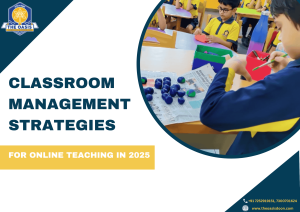
The landscape of education remains to transform at a lightning pace with the help of technology and changing worldwide learning requirements. As schools adopt innovative Classroom Management Strategies to adapt to this shift, online learning has become a common practice—even in reputed schools such as well-known boys boarding schools in India, where blended learning is now an integral part of the academic system. where mixed learning has become an integral component of the academic system. but moving from conventional classrooms to virtual learning environments poses new challenges—especially in terms of monitoring student behavior, focus, and participation. This is where Classroom Management Strategies come into play.
- Why Classroom Management Strategies is Important in Online Learning
- Setting Clear Expectations from Day One
- Using Technology to Increase Engagement
- Fostering Relationships and Building Connection
- Maintaining Accountability and Responding to Misbehavior
- Promoting Self-Regulation and Discipline
- Parents’ Role in Classroom Management in the Online Classroom
- Sustained Improvement and Feedback
- Final Thoughts
- Frequently Asked Questions (FAQs)
Why Classroom Management Strategies is Important in Online Learning

Redefining Discipline and Structure in Online Classrooms
Unlike traditional classrooms, online classes do not have the immediacy of a teacher’s presence and peer pressure that tends to automatically enforce discipline. This necessitates the creation of well-structured systems that maintain students’ focus, motivation, and accountability.
For students in fast-paced settings such as boarding schools or remote learners, predictability of expectations and routines is essential. Effective Classroom Management Strategies provide a balanced understanding of academic demands and emotional health.
Setting Clear Expectations from Day One
Establishing Rules and Routines
Clear standards for behavior, participation, and time management form the foundation of handling any classroom—particularly virtual ones. These can include:
Logging in on time
- Keeping cameras on (where possible)
- Remaining muted until called upon
- Active participation in class discussions
Students are more responsive when rules are negotiated together. Allowing students to have a say in establishing some norms makes them take responsibility.
Communicating Expectations to Parents
For younger students frequent updates to parents assist in reinforcing rules in the home or hostel environment. A basic weekly checklist or behavior summary would suffice in ensuring all stakeholders are on the same page.
Using Technology to Increase Engagement

Interactive Tools and Platforms
Online platforms in 2026 are smarter and easier to use than ever. Educators now have the option of using tools such as:
Breakout rooms for collaborative work
- Digital whiteboards for brainstorming
- Gamified quizzes to enjoy studying
- Live polls and reactions for immediate feedback
These tools don’t only enable learning to become interactive—they’re also excellent Classroom Management Tactics that eliminate boredom and enhance concentration.
AI-Powered Learning Analytics
Contemporary learning platforms provide instant feedback on student engagement, screen usage, and assignment submission. Teachers can leverage this data to adapt their style, allowing them to spot disengaged students early on.
Fostering Relationships and Building Connection
Promoting Student Voice
The most common complaint of online learning is disconnection. Students typically experience loneliness, particularly in too structured or too quiet courses. Teachers can include:
- Student-led presentations or sessions
- Feedback surveys to express concerns anonymously
This makes students feel heard and respected—an underappreciated but powerful Classroom Management Strategy.
Fostering Peer Collaboration
Peer reviews, virtual study partners, and group projects assist in simulating the social dimension of learning. When working in groups, discipline tends to get better automatically as peer accountability is enhanced.
Maintaining Accountability and Responding to Misbehavior

Monitoring Attendance and Participation
Unlike roll calls of yore, platforms today monitor log-in times, engagement, and session activity. Teachers should:
- Use dashboards to track performance
- Tackle lack of engagement early
- Following up with parents if the behavior continues
Enforcing Consequences Respectfully
Consequences in online classes should be corrective rather than punitive. For instance:
Sending a warning message for habitual disruption
- Assigning reflection activities
- Engaging parents in ongoing misbehavior
Regular enforcement of rules is one of the most reliable Classroom Management Strategies for maintaining order.
Promoting Self-Regulation and Discipline
Time Management Skills
Students are likely to lose sight of time when studying in a less structured home setup. Teachers and parents must assist students in utilizing:
Digital calendars or calendar apps
- Pomodoro timers for concentrated study
- Visual schedules for daily routines
- These tools instill responsibility and minimize distractions.
Supporting Emotional Well-being
Effective Classroom Management Strategies must also account for students’ mental well-being. Providing mental health breaks, mindfulness exercises, and open communication channels assists students in handling pressure and remaining engaged.
Parents’ Role in Classroom Management in the Online Classroom

Establishing a Learning-Friendly Environment at Home
The parents are chiefly responsible for establishing a peaceful and structured learning environment. This entails:
Having a quiet, lighted study space
- Reducing background distractions
- Establishing regular sleep and study schedules
Being a Positive Reinforcement Partner
Positive reinforcement in the home for positive online behavior reinforces what you are working to accomplish. Reward regular attendance, active participation, and completion of assignments with special privileges or compliments.
Sustained Improvement and Feedback
Getting Feedback from Parents and Students
At the end of each month or term, collect feedback on how to better improve your strategies. Sample questions can be:
What went well this term?
- What was challenging for you?
- How can we enhance participation or clarity?
This collaborative nature makes each person feel responsible for improving the class experience.
Adjusting to Changing Needs
Classroom situations shift rapidly, particularly online. Being flexible and responsive to change is essential to success. Teachers need to be current with changing platforms, teaching styles, and Classroom Management Strategies that correlate with student needs.
Final Thoughts
Online learning in 2026 is both an opportunity and a challenge. Whether it is in high-tech city schools or acclaimed boys boarding schools in Dehradun, the management of a virtual classroom needs a holistic strategy. With balance between structure and empathy, judicious use of technology, and engagement of parents and students, teachers can create an online classroom that is disciplined as well as dynamic.
Classroom Management Strategies are not mere rules—rather, they are the foundation of effective online learning. To students, they provide clarity and consistency. To parents, they mean worry-free school years. And to educators, they set the stage for learning to flourish.
Frequently Asked Questions (FAQs)
1. Why are Classroom Management Strategies crucial in online teaching?
They assist in maintaining discipline, concentration, and motivation in a virtual environment where distractions are the norm and physical supervision is not feasible.
2. How can parents collaborate with online classroom management at home?
By establishing routines, maintaining a distraction-free environment, and being engaged in their child’s academic progress.
3. What are some effective tools for managing online classes in 2026?
Advanced platforms provide functionalities such as breakout rooms, engagement analytics, digital planners, and AI-powered student tracking to efficiently manage classes.
4. How do students remain focused throughout online classes?
By utilizing time management tools, reducing distractions, taking brief breaks, and engaging in lessons attentively, students can remain focused.



